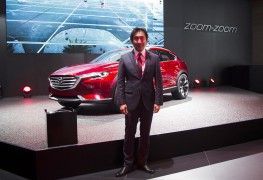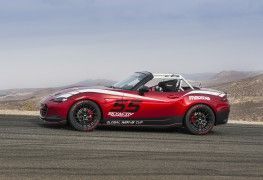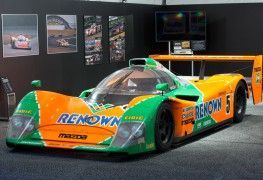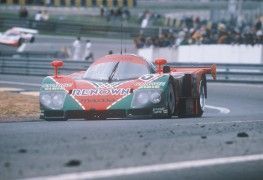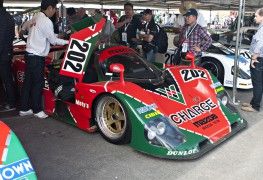Curiously, the devaluation of this third generation seems to us more pronounced, and the available cars more interesting to buy, than those of the second generation. For little more than 10,000€ you can find units in good condition of the NC, when for a good NB with self-locking differential and six-speed gearbox you can easily pay 7,500 or 8,000€.
Personally I'm a fan of this third generation of the model, being the most appropriate for me to buy.
Design
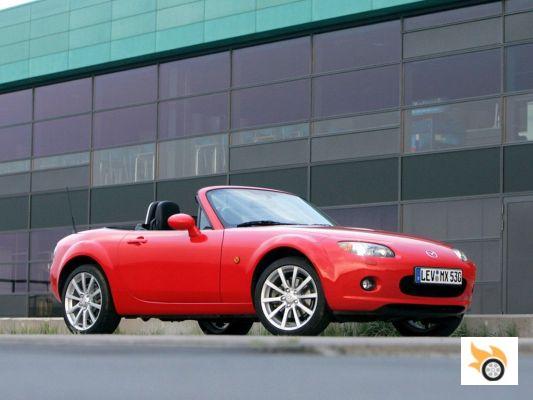
Although behind closed doors it was decided to opt for an "evolutionary" design for the MX-5 with the arrival of the third generation, it is clear that there was a very marked break from the road already traveled the previous 16 years with the first two generations of the model. The NC introduced many changes in the general language, even if some key elements were kept, which even disappeared in the restylings.
For starters, the organic design craze of the 1990s gave way to the "solid and technical" design language that Mazda had already undertaken with other Mazda models, such as the RX-8. Also imported from the house language was the theme of the wheel arches with pronounced circular fins, which protruded from the ovoid body of the body.
The result is a car that looks more solid, bigger, but also more "powerful". Although the loss of the organic can subtract muscularity at a "traditional" level, the car loses its "animal" connection, its felinity, but also part of its femininity, to opt for something colder, but at the same time more "Japanese manga".
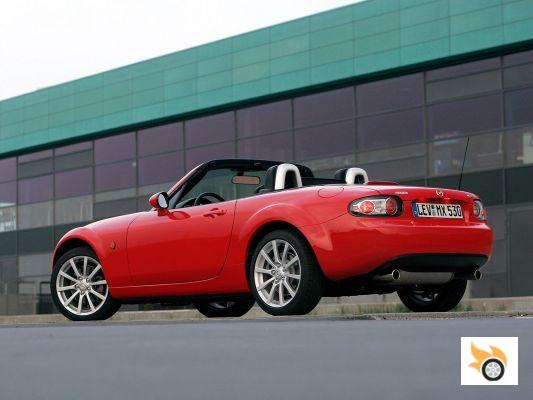
It made rivers of ink to be written about it, but the MX-5 NC, at least for me, is a sample of a well-executed design, which does not age with the passing of the years. And eight years after it hit the market, it still looks fresh, even though it was just replaced a few months ago.
Personally, I like this generation the most. In addition, the amount of body accessories available on the market, both official via MazdaSpeed, as unofficial, is huge, as to configure and customize the car to your taste and measure.
One of the car's most aesthetically distinctive concepts is its ground clearance and tyre-fin distance. Unlike the first two generations of the model, the NC employed the new long-travel suspension concept debuted on the RX-8 (from which its suspension is derived). Using this concept allows the car to move more to stick to the road, but requires more wheel clearance. Many users choose to lower the ground clearance, which compromises this solution, but we must admit that visually, both lowering the height and widening the tracks work wonders on this car and give it more presence. The question is whether you are willing to sacrifice dynamism or comfort for aesthetics?
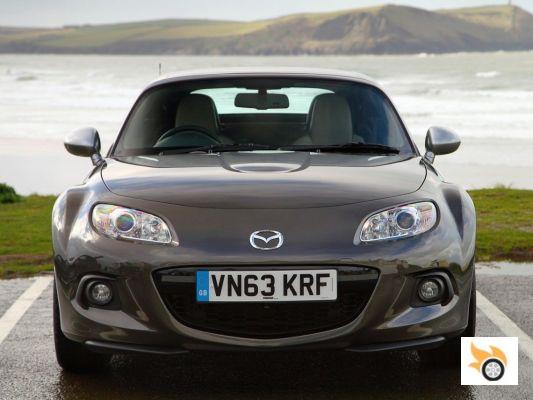
Second restyling of the Mazda MX-5 NC
From the first restyling of the model (there were two major evolutions, known as NC2 and NC3) the model lost its Lotus Elan-style oval mouth to gain a mouth with the typical Mazda shape.
Cabin
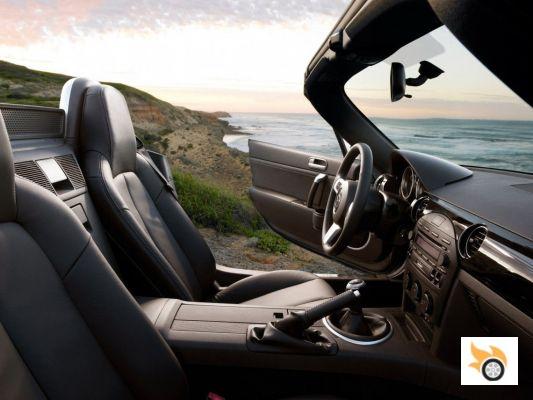
Bigger on the inside than ever before, suitable for virtually any size, and with the benefit of real roll-over roll bars. Thus, the MX-5 NC put an end to everything that had been the Miata until then, to evolve in a positive way. Sitting in one is to easily find the desired driving position (although the steering wheel can not be adjusted in depth).
Materials and finishes are of high quality, as is the steering wheel. The standard audio system, with BOSE amplifier is great, but after the restyling and out of necessity and market appetite, an optional infotainment system was offered in the form of a touchscreen with navigation that didn't fit as well as the standard radio... Personally, visually, I'll stick with the traditional radio. Ultimately, with a little tweaking it will accept streaming audio over bluetooth, so you'll have everything you need to enjoy the car. Need navigation? You can always turn to your mobile phone or a TomTom for that.
The 150-litre boot is more than enough to carry the luggage of a couple on holiday, and I don't think you'll be moving around in it to complain about lack of space. The roof, remember, can be manual textile, or automatically retractable and rigid. The hardtop offers much better sound and thermal insulation, and if you're going to travel on the motorway you'll be grateful for it. The fabric one is "more authentic" in the sound of the rain falling on it, or in the manual operation of it, or in the weight savings it offers, but I will tell you that it is advisable to go for what best suits you depending on the type of use you are going to give it. The more motorway miles you're going to do, the better to go for the folding hardtop.
Engine and technology
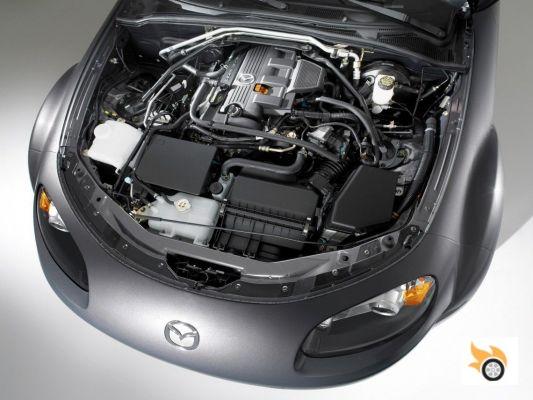
Two variants of the same block were offered for sale. One with more cylinder bore than the other. Thus, the basic MZR engine was a 1.8-liter with 126 horsepower, while the other engine was the two-liter with 160 horsepower. The first engine was offered as standard with a five-speed manual gearbox, while the second could be purchased with a six-speed manual and a torsen-type self-locking differential.
In addition, in Spain, the model with retractable hardtop and two-liter engine had Bilstein damping as standard, much more achieved in the control of body movements.
Returning to the engine, as we told you yesterday in the history of the model, it is an engine completely made of aluminum alloys, extremely reliable, and with variable valve timing. From the first revision of the model (NC2), the two-liter stretched its maximum engine speed up to 7,000 rpm, but without gaining power (it lengthened the range of use of the engine).
Of the two engines, the two-liter feels much quicker. The 34 horsepower difference is already noticeable in itself, but also the torque and power delivery curve gives the feeling of being flatter, so when choosing an engine you have to go for a two-liter "yes or yes", if you are interested in driving "light", and not only in strolling posing with your convertible.
Driving
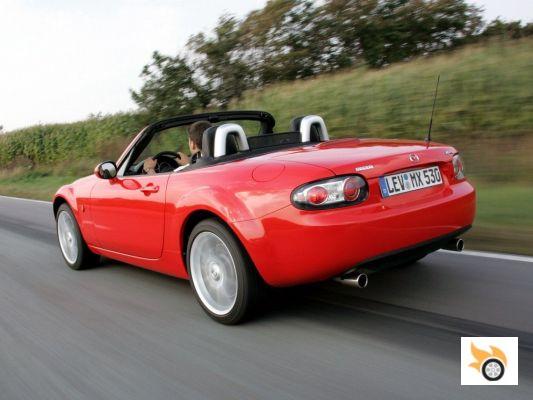
What was maintained with respect to the first two generations of the model was that feeling of connection with the road, no doubt. It's a car that makes you feel what's under the wheels through all your senses. The power steering is a little light, but you get used to it.
The suspension has a lot of travel, and the stabilisers let the car sway quite a bit before it reaches the right support, but once there, it's a solid car in its line, which swallows potholes as if nothing had happened, without breaking the trajectory. The level of motoring is wildly high, so you won't be crossing "barbarically", but it's one of those "flow through the curves" cars, the kind that goes where you want and goes where you want, and with which you can have fun going at 70%, without risking your license or your life.
The fact that the body moves "so much" also makes you aware of what is happening, and you can notice the weight transfer, something sometimes complicated in cars so low and with so little polar moment of inertia. Versions with Bilstein suspension only improve on this front, with more controlled body movements.
The front end changed from before to after the first restyling, after the roll centre height was reduced. The problem was that this was too high originally, and made it difficult for some people to trust the front end when cornering. The change in front suspension geometry made the nose more incisive.
Compared to previous versions, refinement grew a lot, and that spoiled some of the crisp road engagement of previous versions. The extra suspension travel and its filtering capacity were to the benefit of stability, cornering and comfort, but the car ends up feeling a hair more filtered. Personally I'll tell you that, despite this, it's still great fun to drive.
It's a noisy car for constant motorway use, even with the hardtop fitted. Its average fuel consumption of ten litres per hundred in the real world can't be considered poor these days, but it's nothing to cry about either. As a daily driver's car it's more than adequate, as long as you keep fuel consumption in mind.
To review
It's a tough as nails car. The change to a chain-driven engine means that there are hardly any engine problems. The only thing that Mazda indicates is to use the "official" coolant of the brand and replace it every two years, and is that the alloy of the aluminum block is very sensitive to oxidation if this is not properly cared for, so it is advisable to see if the car has passed its revisions in official workshop or at least with the official material.
On the chassis level, the NC managed to get rid of the rust, and has no known problems on this front. The only faults we have managed to find consistently in this car are the generation of fractures in the windscreen, something to which it is particularly sensitive, the rapid deterioration of the rear shock absorbers, and the fact that the gearbox in cold is complicated in its change from first to second (once warm it has to go as smooth and great as with the rest of gears).
Otherwise, it is a car that if properly maintained, has no defects whatsoever, which is shocking, for the good.
The condition of the soft top, if it's cloth, is vital. If it's bad, look for another unit, as it's expensive to repair.
Maintenance
Another positive aspect of the MX-5 NC is its maintenance cost. It's not as economical, of course, as its ancestors, but it's still not prohibitively expensive by any means.
Basic maintenance includes an annual or every 20,000 kilometres service, which in an official workshop can cost around 300€. Every 100,000 kilometers spark plugs are changed, so the bill increases a little more, up to 450 € approximately. To that you have to add the change every two years of coolant (as you tell us in the comments, many units in Spain came with coolant without maintenance, which only requires replacement every 11 years) and brake fluid plus typical maintenance (brake pads and discs, the first can last 65,000 km, the latter, 130,000 km, without problems). The clutch also lasts well: well cared for, it will last more than 100,000 km.
As the engine has chain timing, there is no need to change the timing, which is good news in itself.
As for the tyres, it fits much more than the NA and NB: 205/45 R17. This can lead us to spend up to 140€ per wheel if we mount a good brand (Bridgestone, Michelin...) although for much less we have Toyo. It's still not an extra-expensive shoe, but it's no longer the 50€ of the previous models. In any case, it is not a car that devours tires in quantity, and with a swap every 15,000 or 20,000 km, we will extend its use a lot.
Modifications
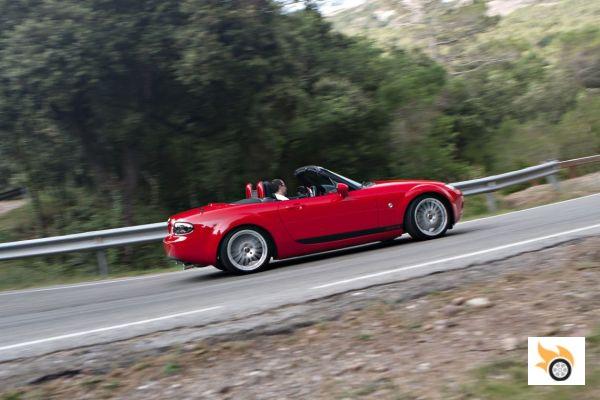
It's a matter of personal taste. Suspension tweaks and sport exhausts are the most typical, along with rims. The RX-8's stabilizers are compatible with the MX-5 NC, so there are more than a few who have installed them to eliminate some of the Miata's characteristic roll.
Mounting stiffer springs and dampers is always an option if you like to go hard with the car, and the truth is that the Bilstein offered by Mazda itself go very well, but if you go a step further towards the stiffer you can end up ruining the driving experience, even if it is to have a cooler aesthetic, with the car more "thrown on the asphalt".
Boosting the engine is tricky. Mounting a turbo, with our current homologation regulations is a pain, and tweaking the naturally aspirated to get more horsepower is complicated, beyond playing with intake, exhaust and ECU, which can give you a pinch of extra power, but nothing that is going to be decisive. In any case, it is not a car that lacks power with its 160 horsepower, as its essence is not that of a dragster of impossible accelerations, but a car to draw curves flowing.
Aesthetically, as mentioned above, it has a thousand and one options, with official MazdaSpeed body kits, RAYS wheels ... in short. A very long way to explore.
Conclusions
Good, beautiful, reliable, cheap, fun to drive... what more could you ask for? It's one of those cars that transmits good vibes and character when you drive it.
Don't be fooled, if you're looking for efficiency, crazy cornering, a kick of acceleration in the kidneys and a car that breaks down on its line in strong support, the MX-5 is not what you're looking for. It's not a badass in any of those ways, nor does it want or need to be.
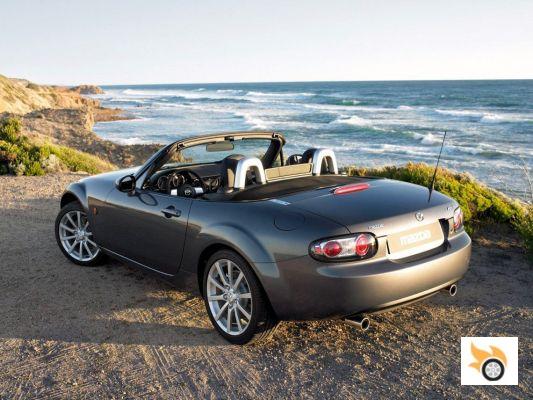
The Miata is a much more sedate and fun car at the same time. It's a car that pulls lines, lines well, brakes hard, enjoys the way it enters the corner and comes out of it. It is a car that pleases by the feel of its gearbox, its modulation through the progressive accelerator pedal or the feel of the brake pedal. It's a tremendously well-tuned machine.
Some people will tell you that a I-don't-know-what is faster at the Nürburgring, that their Leon Cupra accelerates faster, or that their Golf GTI has more horsepower. But at the end of the day, on the same winding road, you'll be able to enjoy the car, the road, and all without having to risk your license and your life to do so. And sometimes you have to realize that enjoying driving doesn't always have to be synonymous with being scared or impressed by accelerator kicks... In that, the NC is the master, without a doubt.
My purchase recommendation would be an NC with a two-litre engine, manual gearbox and... the roof to your liking: if you occasionally travel on motorways and motorways at over 100 mph, you'll appreciate the hardtop. If the car is going to be a weekend treat, canvas.
A tribute to Mazda and its sporting and technological heritage